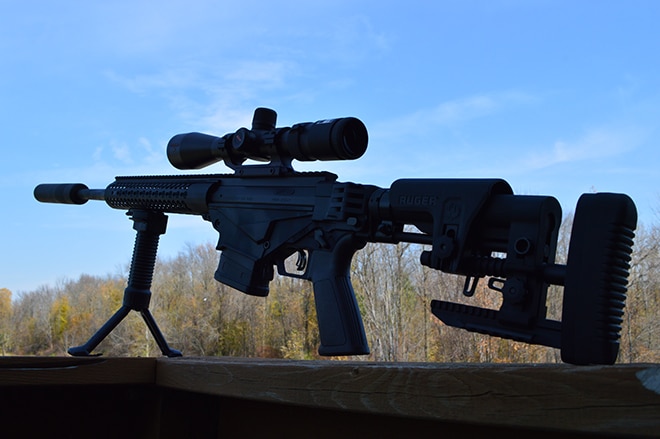
Nikon Prostaff 7, ready for action on a Ruger Precision Rifle in .308. A Prostaff 7i rangefinder completes the set. (Photo: Kristin Alberts)
Hunters are always searching for the best, most cost-effective optics. Nikon’s ProStaff 7 line may just be the greatest bang-for-your-buck, in more ways than one. Does the combo live up to the hype, or are these higher-feature-lower-budget rangefinders and scopes overrated? The proof is in the field.
Scope: ProStaff 7 in 4-16×42

Nikon ProStaff 7 in 4-16×42. (Photo: Kristin Alberts)
We had the pleasure of shooting the newish Nikon ProStaff 7 in 4-16×42, with side focus and a BDC reticle, mounted atop Ruger’s Precision Rifle in .308.
The ProStaff 7 is built on a 30mm tube, a feature once reserved only for the highest end optics, granting increased light transmission as well as greater dial adjustment range for windage and elevation. The BDC reticle features Nikon’s see-thru ballistic circles for long ranges and a traditional center crosshair for shorter shots. Anti-reflective, fully-multicoated lenses are nitrogen filled, waterproof, shockproof, and fogproof.
The ProStaff 7 line of optics have spring-loaded instant-zero-reset turrets for quick adjustment, as well as a four-times zoom ratio on all models. The scope gave us very generous eye relief as well.

The Nikon Prostaff 7 is built on a 30mm tube. (Photo: Kristin Alberts)
Visual optics are clear and crisp, even when cranked up to handle ranges of 500 yards from the bench. Target time aside, clarity was excellent for all our hunting applications, and the scope performed above average at the crucial dusk and dawn hours, allowing us to see longer and better than several comparable optics. Our particular test scope in 4-16×42 retails for $449, but sells real-world around $350.
It’s a great middle-of-the-road optic offering many of the features found on scopes for twice the price, and showing off quality far, far superior to cheapo scopes in blister packs.
While many of the major companies are now offering ballistic software online or via smartphone app, we’ve found Nikon’s Spot-On Ballistic Match to be one of the best and easiest to use, especially for beginners. Using the Spot-On technology allows users to maximize use of their Nikon BDC reticles by inputting caliber, bullet weight, load info, and ranges. With a little range time, even inexperienced shooters will have a solid grasp of every mark on the BDC reticle as it relates to the hunt.
Rangefinder: ProStaff 7i

Nikon 7i rangefinder package. (Photo: Kristin Alberts)
You can have the right gun that fits you, the correct bullet for the quarry and the best optic you can afford, but all that is moot if you don’t know the range of your target. We had the pleasure of using the Nikon 7i for our 2015 whitetail hunts, both gun and bow. It quickly accounts for angles, has scan mode, and is more than capable in any kind of weather.
The 7i is touted as able to range 8-1,300 yards, and while we didn’t have any targets at that exact range, we found the device dead on for known targets at 750 and 870 yards. The digital display readout is clear in all light conditions, and even after a full season of use, never moved below ¾ battery power. The 7i even picks up animals in the woods or in brush cover with its accurate crosshair aiming system. Scan mode allows up to 8 seconds of continuous ranging, a feature we used quite often to ensure we were on our intended target.

Nikon Prostaff 7i viewfinder detail. (Photo: Kristin Alberts)
With its 6×21 zoom, the 7i made my late-season whitetail hunt a success, as I was able to harvest a trophy buck at 364 yards. The 7i ranged the buck accurately, and I had time to confirm the range by checking it against a heavy brush line behind him. Knowing the exact range allowed me to place the correct BDC reticle on his vitals and place a double-lung shot.
The ProStaff 7i is not limited to gun hunters; rather, the angle mode accounting for up to 89-degree angles makes it ideal for bow and crossbow hunters as well, and with its help, we were able to make a clean crossbow kill knowing our exact range at 42 yards from an elevated stand, information that was critical to shot placement. The Nikon 7i Rangefinder is selling for $299 on Nikon’s website.
Conclusion
With the ProStaff 7 riflescope, you get the features of the higher-end, higher-dollar optics: a 30mm tube, multi-coated lenses, spring-loaded zero-reset turrets, side focus, multiple reticle options, and a paired ballistic technology. In the 7i Rangefinder, you get more features and more range than comparable models charging half again as much.
While no amount of optics or gadgets will compensate for lack of practice or poor hunting skills, making use of the correct glass can help make your hunt a success. While we certainly don’t consider the Nikon ProStaff 7 line to be “cheap” optics, they are priced more on the budget end of quality glass from a company with a solid reputation in the industry. If you’re new to pairing rangefinders and optics, or looking for a reasonably priced workhorse combo, take a look at Nikon ProStaff 7 line.
The post Gear Review: Nikon ProStaff 7 Scope & Rangefinder combo appeared first on Guns.com.
